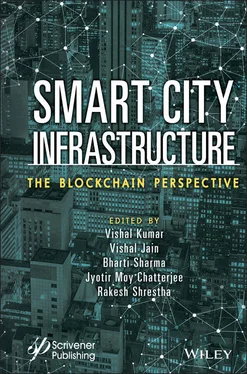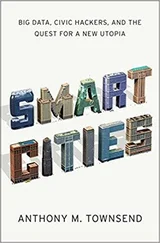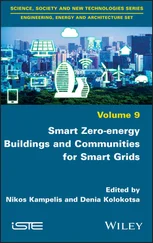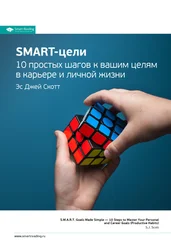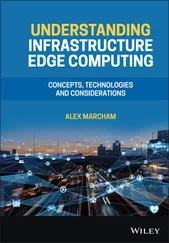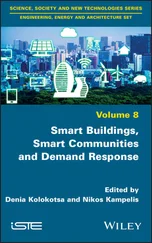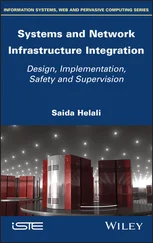Smart City Infrastructure
Здесь есть возможность читать онлайн «Smart City Infrastructure» — ознакомительный отрывок электронной книги совершенно бесплатно, а после прочтения отрывка купить полную версию. В некоторых случаях можно слушать аудио, скачать через торрент в формате fb2 и присутствует краткое содержание. Жанр: unrecognised, на английском языке. Описание произведения, (предисловие) а так же отзывы посетителей доступны на портале библиотеки ЛибКат.
- Название:Smart City Infrastructure
- Автор:
- Жанр:
- Год:неизвестен
- ISBN:нет данных
- Рейтинг книги:4 / 5. Голосов: 1
-
Избранное:Добавить в избранное
- Отзывы:
-
Ваша оценка:
- 80
- 1
- 2
- 3
- 4
- 5
Smart City Infrastructure: краткое содержание, описание и аннотация
Предлагаем к чтению аннотацию, описание, краткое содержание или предисловие (зависит от того, что написал сам автор книги «Smart City Infrastructure»). Если вы не нашли необходимую информацию о книге — напишите в комментариях, мы постараемся отыскать её.
The wide range of topics presented in this book have been chosen to provide the reader with a better understanding of smart cities integrated with AI and blockchain and related security issues.
Audience
Smart City Infrastructure — читать онлайн ознакомительный отрывок
Ниже представлен текст книги, разбитый по страницам. Система сохранения места последней прочитанной страницы, позволяет с удобством читать онлайн бесплатно книгу «Smart City Infrastructure», без необходимости каждый раз заново искать на чём Вы остановились. Поставьте закладку, и сможете в любой момент перейти на страницу, на которой закончили чтение.
Интервал:
Закладка:
From the literature, PoW has two excellent characteristics: It must be complicated and time-consuming in favor of every entity to make a testimony that convenes particular necessities. It should be quick plus straightforward for others to validate the testimony in terms of its precision. For a block to be legitimate in the blockchain, a miner must calculate the hash-value, which is fewer than or equivalent to the existing objective, then extant its explanation to the setup for authentication through additional nodes. The twin assets of PoW guarantee that it is though then time-intense to discover the correct nonce for the suitable hash objective; so far, it is effortless besides straightforward to legalize the hash product no tamper happened.
1.4.2 Proof of Stake (PoS)
PoSs are broadly applied consensus algorithms in blockchain appliances; it states that an abuser or client can mine or else authorize transactions in a block, depend on the number of abusers or clients. Protocol believes that clients who have more cash are less likely to outburst the setup. Here, blockchain trails on various clients or miners if they hold high crypto-currency named a validator. All validated applicants then carry the procedure of generating and authenticating a new block. The PoS algorithm has numerous tangs, depend on the ways the rewards are consigned. Some of them are chain-based PoS—where a validator is preferred at a random method and a time slot for a new block is created by the authority. Hence, based on time, many blocks unite to a solitary emergent chain. Previous editions of chain-based PoS models build with naïve technique since rewards are utilized to produce blocks with no penalties, pushing them to endure nothing at stake issues. In BFT-style PoS, miners are arbitrarily legalized to advise an original block’s design, but block’s approval made by the multi-round voting method. The PoS characterizes different kinds of distributed consensus protocols for undertaking the confidentiality, accessibility, and privacy properties of public blockchain models.
1.4.3 BFT-Based Consensus Algorithms
The major reason behind the BFT algorithm’s innovation was its tolerance potentiality of a system in opposition to the BGP. For a more detailed explanation, consider a group of nodes where each node grasps a unique initial value. Here, every node must follow the same mind behavior by accepting a consensus procedure’s solitary cost. In such a scheme, an agreement will reach with bulk nodes that consider truthful nodes that thoroughly follow the protocol instructions; still, some nodes molest, deviate from the protocol. This situation is acknowledged as Byzantine fault-tolerant (BFT). We know that long-established distributed computing arrangement controls central authorities, and they conclude what step has to be taken when Byzantine failure arises. The blockchain is a decentralized scheme maintained with a distributed ledger where every node holds the chain or block’s replica. For every applicant block, the authentication is prepared by having the system harmony via the digital signatures of an adequate amount of nodes. Only those applicant blocks the system confirms those can be linked to the blockchain. To avoid Byzantine faults, blockchain must apply PoW and PoS consensus models to approve transactions, which turns blockchain more powerful and efficient. However, PoW or PoS is not always a perfect key to deal with BFT issues. Identifying the working procedure of BFT will play a key role in applying blockchain with efficient appliance results. Also, open consensus algorithms and protocols planned on behalf of the Byzantine fault trouble might not be sufficient when functional to additional blockchain appliances.
In 1982, well-known persons like Lamport, Pease, and Shostak introduced the leading solution to resolve BFT misconceptions and prevent associated mistakes. Miguel Castro and Barbara Liskov anticipated the PBFT model for realistic BFT in 1999 for the Byzantine state mechanism’s high-performance reproduction. AlgoRAND and Honey Badger BFT are two exceptional works that describe various concepts of BFT.
1.4.4 Practical Byzantine Fault Tolerance (PBFT)
PBFT is a simulated version shaped to continue Byzantine faults. Specifically, to tolerate the Byzantine fault, we must realize the working style of Byzantine issues illustrated as an agreement issue. Byzantine trouble gets even more composite by continuing unfaithful nodes which might cast a take part in an election for a trivial stratagem. In PBFT protocol, each node recognized by additional nodes in the setup can inquiry with remained. Delegated BFT (dBFT) is a consensus model similar to PBFT, but, in dBFT, a cluster of specialized nodes nominated to sign dealings as different to arbitrary nodes. The justification of a transmission operation can be done in three steps: In the first step, validators specify the reason for transmission of a block when it gains 2/3 votes from the setup. In the second step or pre-commit phase, validators decide to pre-commit on block and transaction deal. Just once, block obtains 2/3 votes for the pre-commit stride when it come in the assigned phase, which is the third step. Here, a node legalizes a block or transaction plus transmits a consign for it.
1.4.5 Sleepy Consensus
The sleepy consensus model builds on the sleepy model concept, where participate or nodes swing in both ways online (awake) and offline (sleep) in the protocol implementation. It is demonstrated to be flexible when the truthful contributors are the mainstream. This algorithm’s most important initiative is to recognize the Bitcoin. But sleepy consensus cannot endure effort in the box when an unfair online group of actors is mainstream.
1.4.6 Proof of Elapsed Time (PoET)
PoET brings low computation with justification, designed by intel via leveraging SGX, a trusted computing policy. In this algorithm, each node waits for the threshold period; here, the node which finishes the threshold time is allowed to generate a new block. The PoET consensus is required to guarantee two key features: First, the joining nodes legitimately decide on a time that is sure arbitrary plus not a shorter interval. Second, the frontrunner concluded the waiting time. However, the issue is SGX is not a reliable, trusted computing skill. Two features proposed to overcome this issue: varying the probability distribution and executing statistical analysis to refuse a few blocks engender by a specific portion of nodes.
1.4.7 Proof of Authority (PoA)
Compare to other mentioned consensus algorithms, PoA sustains fast transactions. The main objective of PoA was that barely validators have the fundamental right to commend the contracts along with new-fangled blocks. A node becomes a validator only when the node receives a high reputation score. Compared to other PoS and Pow, PoA is more vigorous because validators authenticate every transaction or contract with high integrity. If not, nodes are attached with negative status. More importantly, a solitary validator cannot grant any two successive blocks, preventing confidence from being central.
1.4.8 Proof of Reputation (PoR)
PoR considers as an expansion of PoA, which is newly promoted by various research communities. In PoR, reputation is calculated with pre-arranged rules; moreover, different variations and constraints are fine-tuned for its best performances. Once the node establishes a reputation with reliable verification, it turns to an authoritative node.
1.4.9 Deputized Proof of Stake (DPoS)
DPoS is an extension of PoS, aimed to accomplish a distributed consensus in a crypto-currency scheme. It is different from PoS script; valuators of the crypto scheme vote for allot to authenticate then practice a deal in revisit for transaction charges, which is entirely dissimilar PoS where stakeholders authenticate then perform a contract to produce recompences along with transaction charges. Compared to other algorithms, the DPoS is the quickest, prolific, proficient, decentralized, and adaptable consensus replica. Deterministic collection of block producers’ permits contacts will be complete typically in one second. DPoS procedure engages the utilization of trusted sub-networks inside a superior system in which the nodes can be separated into a server or the customer.
Читать дальшеИнтервал:
Закладка:
Похожие книги на «Smart City Infrastructure»
Представляем Вашему вниманию похожие книги на «Smart City Infrastructure» списком для выбора. Мы отобрали схожую по названию и смыслу литературу в надежде предоставить читателям больше вариантов отыскать новые, интересные, ещё непрочитанные произведения.
Обсуждение, отзывы о книге «Smart City Infrastructure» и просто собственные мнения читателей. Оставьте ваши комментарии, напишите, что Вы думаете о произведении, его смысле или главных героях. Укажите что конкретно понравилось, а что нет, и почему Вы так считаете.
